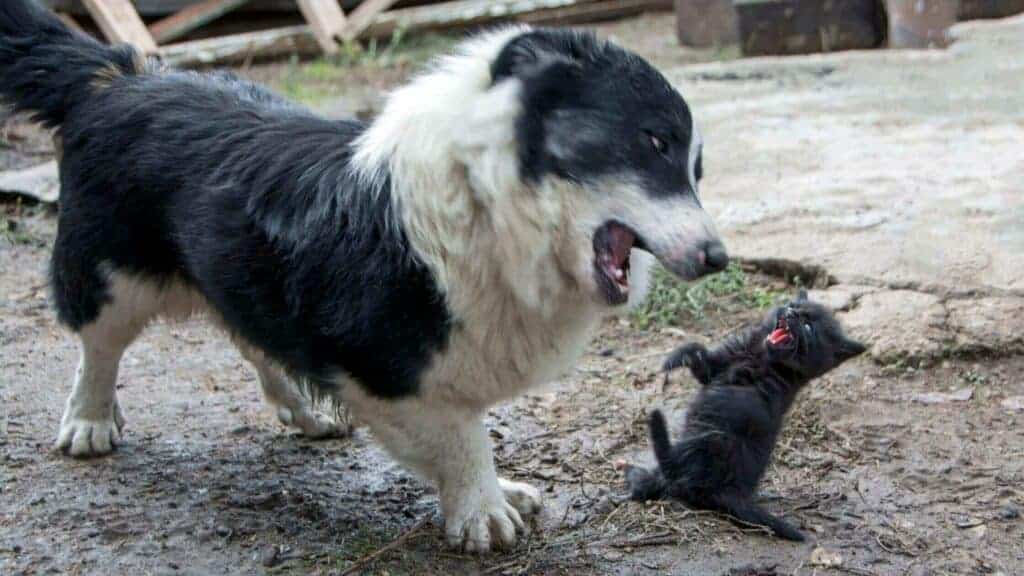
We always assume that our dog and our cat will get along, but this isn’t the case. If you’re noticing that your dog is aggressive toward your cat, or even a neighborhood cat, you’ll want to nip that problem in the bud quickly. Here’s what you need to know.
Helping your dog get over his aggression to cats focuses on a few approaches. The first step is to determine what the cause is for the aggression if you can. From there, you can help retrain the aggression by introducing and re-conditioning the dog’s behavior to environmental exposure, positive reinforcement when interacting nicely, and staying calm and controlled in handling the interactions between your dog and cat.
Dog aggression towards cats is always something to take seriously. Below, you’ll learn reasons for the aggression, signs that our dog might be harboring aggression toward cats, and tips on helping stop the behavior in its tracks.
Why is my dog so aggressive towards cats?
There could be many reasons that your dog is aggressive towards either your cat or a neighborhood cat. Some of the leading ones include:
- Biological/Predatory impulses
- Improper introductions
- Lack of obedience and training
- A previous negative experience with cats
Understanding which of these causes your dog is dealing with can be difficult, but it’s a great starting point to help take the right recovery approach.
Biological/Predatory impulses
While many of us don’t see our furry friend as being much of a predator, dogs are predators by nature. When something small and furry enters their view, their biological, hard-wired instinct (i.e., their lizard brain, based on evolution) will tell them to chase it and “destroy” it to keep its territory safe. Some dogs struggle more than others to overcome this urge, and it isn’t their fault.
Improper introductions
When a dog and a cat are forced into an improper introduction that is either laced with fear or moving too quickly or even forced onto both of them, the dog will associate that fear and negativity with the cat. To protect himself from that fear again, especially if the cat swats and is aggressive in return, he’ll attack aggressively first and ask questions later. Learning how to introduce your dog and cat the right way is critical for safety and long-term companionship.
Lack of obedience training
If your dog runs the house, he’ll simply want to protect you from the cat. If he’s untrained and doesn’t listen to your commands, he’ll see himself as the alpha of your household. If he’s trained, he’ll look to you for direction when he sees a cat. This is because you are the alpha instead. Not to mention that proper obedience is critical to get him to stop a potentially aggressive act in action even if biology threatens to win him over.
A previous negative experience with cats
Similar to the improper introductions, not all experiences with cats are good. Perhaps the dog was terrified or stressed and associated that feeling with the cat. Or, maybe the cat was just plain awful and hurt the dog. A negative experience will cause them to react to protect themselves first, even if this is an entirely different cat.
If you can’t figure out the root for your dog’s behavior, you can consider checking with a vet. However, getting the reason itself nailed down is not crucial for retraining the behavior. It simply helps satisfy the curious human mind!
Signs a dog is aggressive towards cats
There many, many ways that a dog can show his aggression towards cats. Sometimes it starts with one of these and then escalates to more severe ones. Or, perhaps it’s all of these. Every dog and situation is different. Some of the common ones include:
- Barking at doors with cats on the other side or barking incessantly at a cat
- Protecting his food and sleeping area whenever the cat is nearby
- Visual and physical tracking of the cat that can’t be distracted
- He refuses to stay in the room with the cat
- He won’t share his toys
- Physically gets in between his cat and human
- Growling or snapping at cats
These could be signs that you see with either household cats, visiting cats, or even cats in the neighborhood.
Barking at doors with cats on the other side or barking incessantly at a cat
Any time he is around a cat or smells one, he’ll start to bark incessantly. It could escalate, or it could be barks, growls, and other audible signs that he is in “guard dog mode”. If the cat is behind a door, he’ll continuously go and bark at it to “remind the cat” that he is still there and not happy about its presence.
Protecting his food and sleeping area whenever the cat is nearby
If he’s sleeping and the cat wanders in, he’ll jump up and be on guard with stiff movements and won’t relax until the cat leaves again. If he’s eating, he’ll stop and not start again until the cat is gone. He may growl or stay stalky and silent.
Visual and physical tracking of the cat that can’t be distracted
Whether he simply obsessively stares at the cat from one spot or chases it around the house, he’ll do it in a way that will feel eerie to pet parents. This will also be the case if the behavior can’t be distracted by fear or attention.
He refuses to stay in the room with the cat
Your dog may even protest by getting up and deliberately leaving the room when your cat enters it. It’s kind of funny to most of us, but it is something to take seriously as a sign that your dog isn’t happy.
Dogs get as possessive over their toys as they do their food and sleeping space. If he refuses to share his toys with the cat, there could be an issue with further aggression.
Physically gets in between his cat and human
Most assume that a dog is jealous (which he kind of is), but it’s more than that, too. If you’re petting the cat and the dog barges into the room and physically separates you, this is a sure sign (especially if he does it every time).
Growling or snapping at cats
The fur will raise, and he’ll growl, bark or snap and lunge at cats. It could be from a distance, or he could race right up to the cat and do it there. Either version is just as serious.

Can a dog kill a cat?
Yes, a dog can kill a cat. The unfortunate reality is that it happens a whole lot more than you might think. If you notice that any of these signs of aggression show up in your dog, it’s essential to address them to keep this sad potential reality from becoming yours. It’s always heartbreaking, whether it be your cat, a friend’s cat, or a random stray neighborhood cat.
What should I do if my dog’s killed a cat?
If you’re here because your dog has already killed a cat, this is one of those genuinely tragic situations where it’s hard to know what to do. The most common result is that you feel the need to euthanize your dog.
Outside of a court of law (assuming it’s a friend or a neighbor’s cat, and they decide to press charges), putting your dog down is not an ethical decision. Regardless of the situation, a dog is acting on either a biological or learned behavior. He cannot understand his behavior as bad or wrong, and euthanasia isn’t going to change that. It simply causes more pain. Giving him up to a shelter or throwing him out of your home isn’t going to be any better. As hard as it is to accept, it truly isn’t his fault.
The best thing you can do is feel your loss and then use that energy to adapt your dog’s behavior for the future to prevent it from ever happening again.
How Can I Stop My Dog From Being Aggressive Towards Cats?
The approach to stopping your dog’s aggression will depend on whether you want to retrain his behavior for your cat or a neighborhood cat.
Retraining behavior with my cat
Firstly, make sure your dog knows that you are the alpha. He should know commands that make him stop what he’s doing, and he should be able to obey them. Typical examples are “stop” or “leave it”. Use these whenever you see your dog activating aggressively.
Next, you’ll need to help your dog “re-learn” his introduction. As mentioned, understanding how to introduce your dog to your cat safely will be crucial to helping them get off on the right foot — paw.
Once they’ve been introduced, never leave them alone together and watch their behavior. If any aggression pops up, use the command your dog knows and separate them. Do this as long as you need to.
If you need professional help in cases where your dog’s aggression is especially strong and deep-rooted, there are many resources out there to help you!
Retraining my dog’s behavior with street cats
If he reacts to cats on the street when walking him, you can follow a lot of the same steps. Work on teaching him a command, and use it every time he starts to growl or act aggressively.
For safety and control, never let your dog off the leash when there are cats around, even if you don’t think he’d go after them. Try to avoid cats as much as possible at first, and then slowly introduce them to his walking/exploring life by using the commands and positive reinforcement. This will help make sure that he doesn’t go after cats that enter his territory.
How can I help dogs get along with cats?
Whether you are retraining the aggression or simply looking for tips on how to help dogs get along with cats, here is the main thing to keep in mind:
- Stay in charge and control the situation.
- Ensure your dog listens to your commands and that he does as he’s told.
- If there is aggression and fighting, stay calm and remember to focus on the commands.
When it comes to general behavior, the key’s going to be proper, respectful introductions and paying attention to their body language. Never force dogs and cats together and respect the fact that they may want to be distant friends and nothing more!
It’s never fun to find out your dog is aggressive to cats, but learning the reasons, signs, and what to do about it will help protect everyone’s safety and comfort.
In conclusion
Aggression towards cats, in dogs, can come from several causes and take on many forms. Recognizing those signs and knowing how to retrain behavior is crucial to keep everyone safe and as happy as possible.
Did any of this surprise you? Do you know someone who could use this advice to help them and their dog? Please send this to them!
